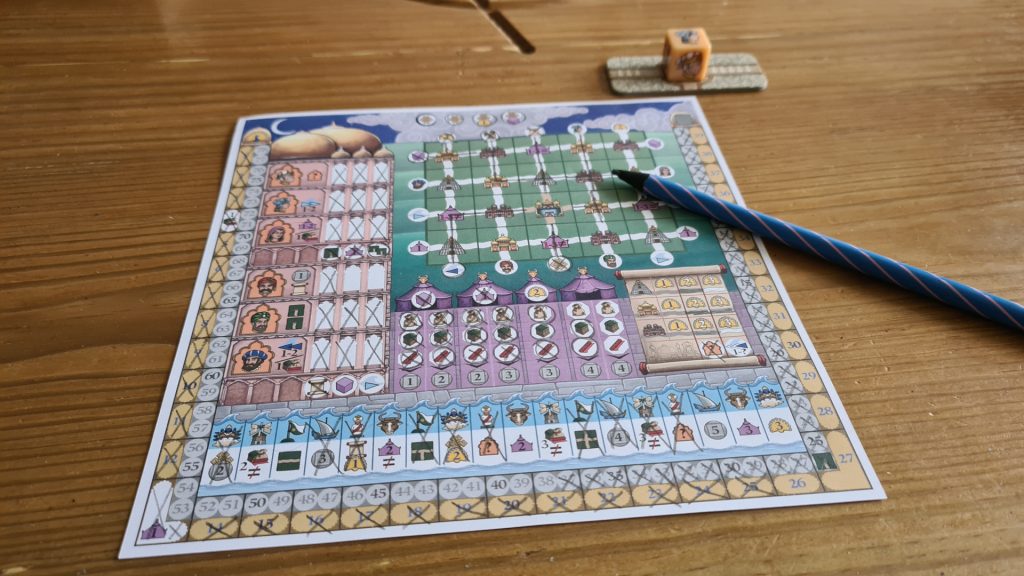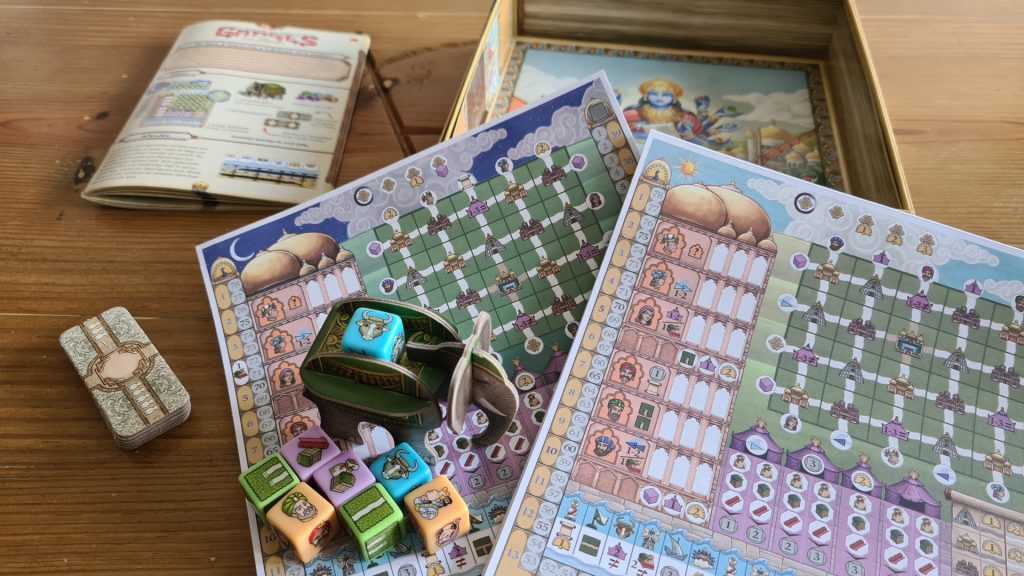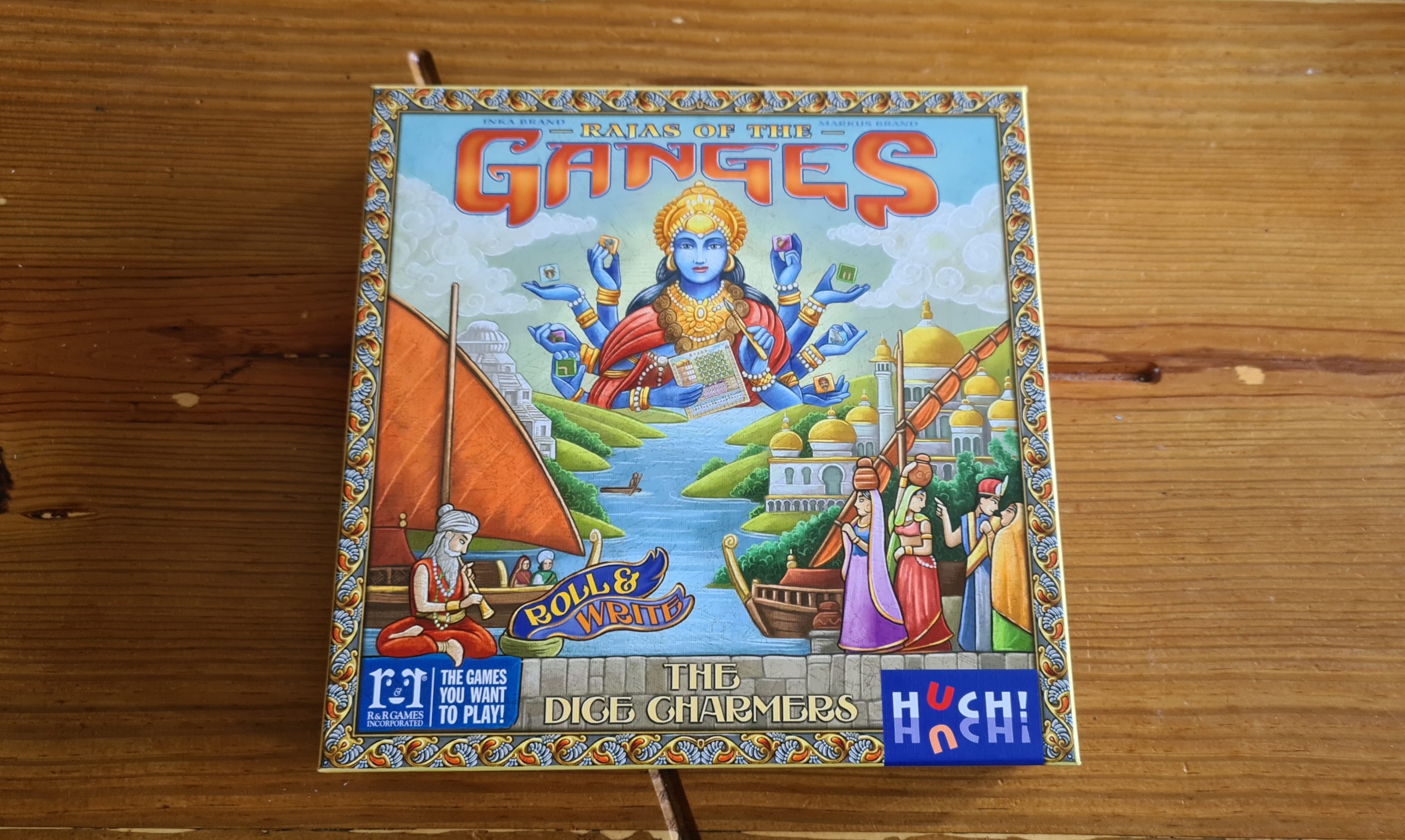Rajas of the Ganges The Dice Charmers is the brand new roll and write board game from publisher HUCH! Designed by Inka and Markus Brand, featuring artwork from Dennis Lohausen, the game sees 2 – 5 players using dice to gain goods to sell, journey along the Ganges river and visit the palace. However, lasting around 30 minutes, is this dice based roll and write different enough from the dice based worker placement experience of the original? Let’s find out!
Setting up is as simple as passing each player a scoresheet – with all players either using a sheet from the Sun or Moon pad. The dice are passed to whoever is going to be the active player in the first round, along with the elephant. At the start of each round the active player rolls the 8 dice, two dice of each colour. Unlike a lot of roll and write games, players then each take it in turns to choose a die from the pool.
The active player has a higher opportunity to hate draft – the process of removing a dice from the available pool purposefully to not allow an opponent to get it. The active player chooses first, but they also then remove the other dice of the same colour from the pool – placing it on the elephant. Players can still get access to this dice, by using some of their limited and collected karma. Karma sees a player take the elephant dice and any other dice in the pool and re-roll them before choosing.
Depending on the die chosen the player will be drawing on their scoresheet in one of 4 locations. The purple dice see them collect the two depicted resources, circling them in the purple tent area of the scoresheets. The blue dice cause the player to sail down the river to the next spot of the depicted symbol, gaining the bonus on the sailed to space. The green dice sees the depicted path shape added to your province network, either from your residence or extending on from an already drawn path. These can be straight lines, corners or 2 halfs. Halfs can be added to already drawn path squares to form T junctions or crossroads.

When a path is drawn it can trigger a building, a market and/or a bonus. Buildings score fame points when linked, with the amount of points earnt upgradeable. Markets allow the player to sell already collected goods for money, seeing them advance on the wealth track. Bonuses around the edges of the province map can trigger the player getting fame, wealth, resources, move along the river and much more. The final place is visiting the palace, with the orange dice featuring the faces that match the palace actions. These range from advancing on the river through to drawing roads in your province – with each able to be used 3 times in a game.
Once everyone has taken a die, and activated it and any bonuses triggered, the next player clockwise becomes the active player. They roll the dice for the new round and so on. The game continues until one player manages to score enough fame and/or wealth so that the two tracks cross. When this happens the current turn of taking dice is completed. At this point the player who has made the tracks cross by the most wins, with ties split by karma.
One of the interesting things about the original Rajas of the Ganges was the way that a player wins. This race to cross wealth and fame returns to great effect. While unable to ever spend money, which perhaps made the decisions more difficult in the original, players are free to zoom up either track. Interestingly, it is almost like the two map sheets (sun and moon) are meant to drag players towards either wealth or fame, with the bonuses on offer for progressing around only one of the tracks on each map.
When it comes to the dice or the individual bonuses the actions in Rajas of the Ganges The Dice Charmers are simple. After a few turns the simple choices start to cascade. After a few dice, players can have goods to sell – so constructing a market, triggers them being sold, gaining the player coins and if selling enough triggering another bonus. Perhaps this is a movement on the river, free goods or the ability to upgrade the value of a building type. This is just one example of how the game swiftly fills up with combos galore. With every other turn then being much bigger than “just” taking a die, there is the potential for analysis paralysis. As long as players don’t take too long calculating their options then the game is fairly fast paced, though it may be a concern for some.

Switching from the Sun sheet to the Moon sheet there thankfully isn’t an abundance of additional symbols to learn. Only one new symbol appears, being a slightly different river choice – so it is more of a new version of an already known symbol. So why does the rulebook recommend starting with the Sun sheet? It’s hard to pinpoint exactly why. There does seem to be slightly more chaining combos possible on the Moon side, though this is in part due to the more you play the game the better you become at triggering long chains of things from one die.
The scoresheets are rather full, looking a tad daunting at first. Not only is a lot crammed in but there are symbols everywhere. Once actually playing it’s extremely quick to pick up, with the majority of the symbols reused and very intuitive. Coming with two slightly different pads of sheets adds some variety to the experience. The dice themselves use colour well to indicate the area of the sheets that they will be impacting, again featuring the same range of symbols. The final component, which is almost a spot of fun, is the elephant for the active player to place a die on each round. It is a good first player marker, and in game does the job fine. Annoyingly, it will not fit in the box constructed, so the wear and tear of rebuilding it will start to show a lot sooner.
Perhaps due to the speed of the experience, Rajas of the Ganges The Dice Charmers works well with 2 players. There are a couple of tweaks, including both players taking a total of 2 dice each round, though still one at a time. As a result of how the game ends, it can feel odd to potentially end part way through a round at 2, though each player will still have taken the same number of dice. This isn’t to say the game plays worse when others get involved, though with each additional player the game length is increased slightly.
Rajas of the Ganges The Dice Charmers captures much of the original game and translates it well into the roll and write genre. There are the buildings to construct, which mimics the tile placement gameplay, there are bonuses for travelling along the river and the crossing of fame and wealth being the victory condition gives players choices of what to aim for. As it’s own game, the amount of combos, with bits triggering on almost every other turn, make every decision important and more than just a choice of a single dice each turn. It’s those choices each turn that mean Rajas of the Ganges The Dice Charmers will continue to hit the table, time and time again.
(Editor’s Note: Rajas of the Ganges The Dice Charmers was provided to us by Asmodee for the review. The game is currently available from local board game stores! Find your local store here.)

